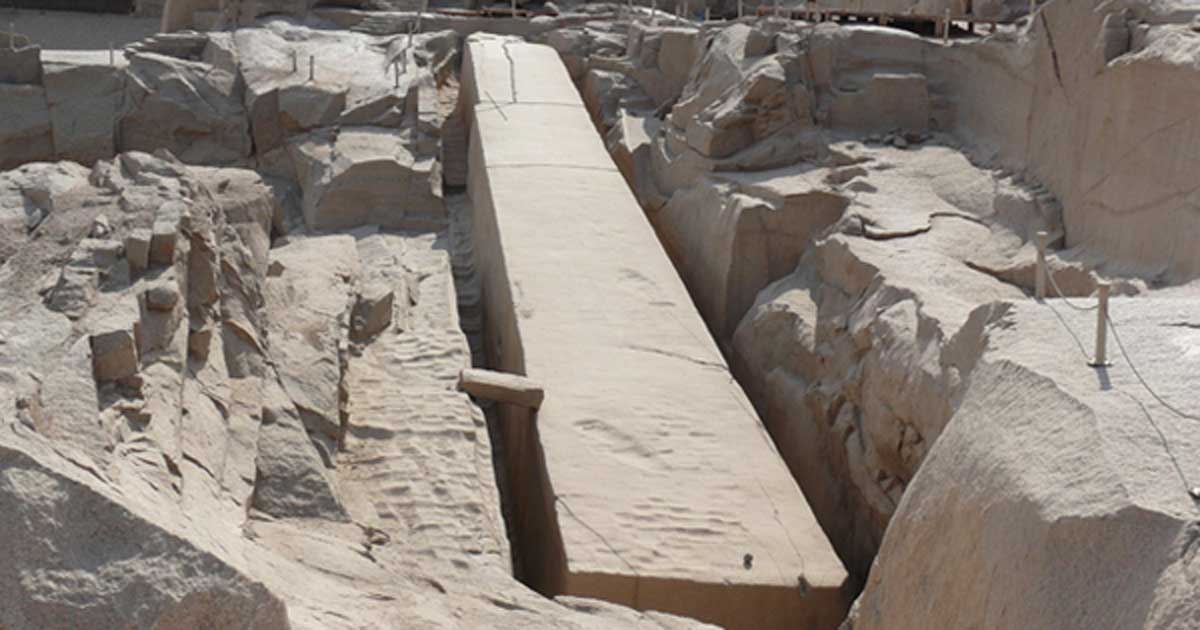Why Did the Egyptian Masons Down Tools on the Largest Obelisk Ever?
The Unfinished Obelisk is an ancient Egyptian obelisk located in Aswan. This obelisk is known for its massive size, as well as for the fact that the work that was carried out on it was never finished. Had the Unfinished Obelisk been completed, it would have been the largest obelisk ever constructed by the ancient Egyptians. Nevertheless, its unfinished state has allowed us to gain some insights as to the way the ancient Egyptians were producing their obelisks.
Egyptian Granite Obelisks
The word ‘obelisk’ means ‘spit’ (a long rod used to skewer food for cooking) in ancient Greek, and was used by the ancient historian Herodotus to describe these monuments. The ancient Egyptians called these monoliths ‘tekhenu’, which translates as ‘to pierce the sky’. As many will already know, ancient Egyptian obelisks are tapering four-sided rectangular pillars with a pyramidon on the top. These were set on bases, and were typically constructed to commemorate an individual or an event, or to honour the gods.

The Massive Unfinished Obelisk in Aswan, Egypt (Public Domain)
The ancient Egyptians carved their obelisks from a single block of stone, almost always red granite. This type of rock is most notably found in Aswan, in the southern part of Egypt. In the granite quarries of Aswan, obelisks would be carved out of the bedrock, and then transported on the waters of the Nile River to their destinations, where they would then be erected.
Abandoned at Aswan
One of the areas in Aswan where granite was being quarried was the Northern Quarries, which is located not far from the modern city of Aswan. It was here that the Unfinished Obelisk was discovered. The construction of this obelisk was commissioned by Hatshepsut (who reigned during the 15 th century BC), one of the most important and formidable pharaohs of Ancient Egypt. It has been speculated that the queen had planned to have the Unfinished Obelisk raised at Karnak. It was at this place that another obelisk, known today as the Lateran Obelisk, was set up by Hatshepsut, and the queen may have wanted the Unfinished Obelisk to complement it.

The Unfinished Obelisk was thought to be a fallen Monument until it was fully uncovered (CC BY-SA 2.5)

The Unfinished Obelisk shows how the stone was carved out of the bedrock (CC BY-SA 3.0)
Unfortunately, the massive obelisk was never completed. At some point of time during its construction, the workmen discovered cracks in the stone, and therefore decided to abandon the job. The Unfinished Obelisk has remained where it was ever since. Had the obelisk been completed, it would have had a height of 42 meters (138 ft), and would have weighed about 1323 ton (1200 metric tonnes), which would make it the largest obelisk ever created by the ancient Egyptians.
Fresh Insights to Egyptian Construction
The abandonment of the Unfinished Obelisk provides us with some new information about how these monuments were made by the ancient Egyptians. For instance, the workers would begin their work by separating the stone which would become the obelisk from the rest of the bedrock. Based on the marks left on the Unfinished Obelisk, this was probably achieved by chiselling holes into the rock, after which wooden wedges were forced into them. The wedges would then be soaked with water, which would cause them to swell, thus splitting the rock. After this, the obelisk could be chiselled out, and then transported to its destination.

The Unfinished Obelisk, the largest known ancient obelisk, located in the northern region of the stone quarries of ancient Egypt in Aswan (CC BY-SA 3.0)
According to a report written in 2007, a deep trench at least 2.5 m (8 ft) deep was discovered by the Aswan Office of the Supreme Council of Antiquities as they were preparing the site for tourists. Further investigations revealed that there had been a canal connecting the quarry to the Nile. This meant that once the obelisks were completed, they could be brought to the canal and allowed to float by themselves down to the river, where they would then be loaded onto barges. The presence of this ancient canal is also a threat to the site, including the Unfinished Obelisk, as it may allow salts from the groundwater to seep into the rock. This could cause much damage, especially to the marks on the Unfinished Obelisk which have been so vital in adding to our understanding of the way the ancient Egyptians created these amazing monuments.
Top image: A photo of the Unfinished Obelisk at Aswan (CC BY 3.0)
By Wu Mingren
References
Ancient-Wisdom, 2017. The Unfinished Obelisk. [Online]
Available at: http://www.ancient-wisdom.com/egyptunfinishedobelisk.htm
Lonely Planet, 2017. Unfinished Obelisk. [Online]
Available at: https://www.lonelyplanet.com/egypt/aswan/attractions/unfinished-obelisk/a/poi-sig/437738/355240
ScienceDaily, 2007. Aswan Obelisk Quarry More Than Meets The Eye. [Online]
Available at: https://www.sciencedaily.com/releases/2007/10/071016131326.htm
Tawsam, 2017. Unfinished Obelisk. [Online]
Available at: http://www.atlasobscura.com/places/unfinished-obelisk
Tour Egypt, 2017. Egypt Travel - Aswan: The Unfinished Obelisk. [Online]
Available at: http://www.touregypt.net/unobelisk.htm
Tyson, P., 1999. The Unfinished Obelisk. [Online]
Available at: http://www.pbs.org/wgbh/nova/egypt/dispatches/990316.html




















Comments
Another great post. Thank you for the information about how the obelisk was created and moved to the site where it would be erected. I have read that obelisks were part of an electricity grid used by the ancient Egyptians. An interesting theory about one of the reason why they erected so many of them. however, I wonder where the electricity was generated. I've heard the Great Pyramid might have been a source buy I doubt even that massive structure could supply the energy demands of everyone.